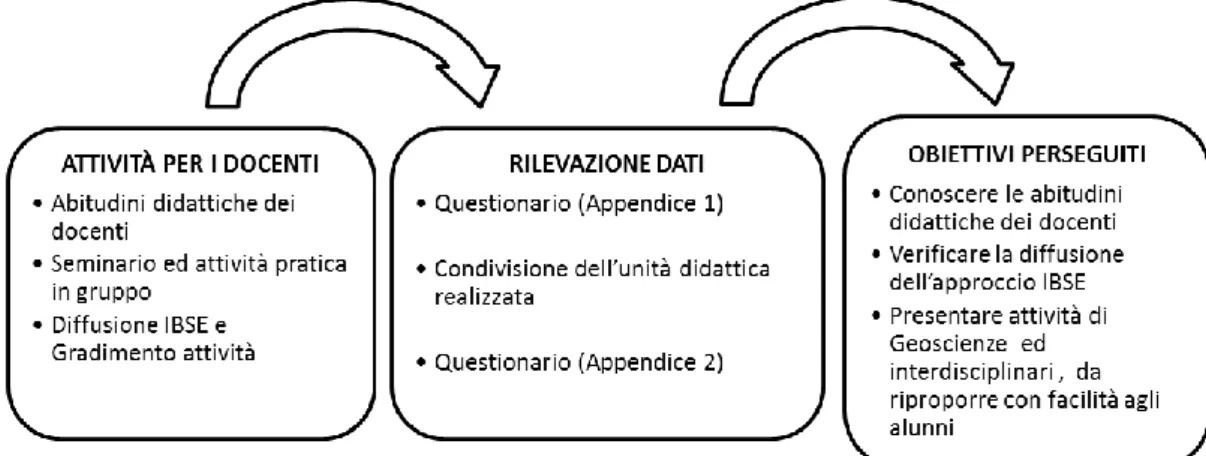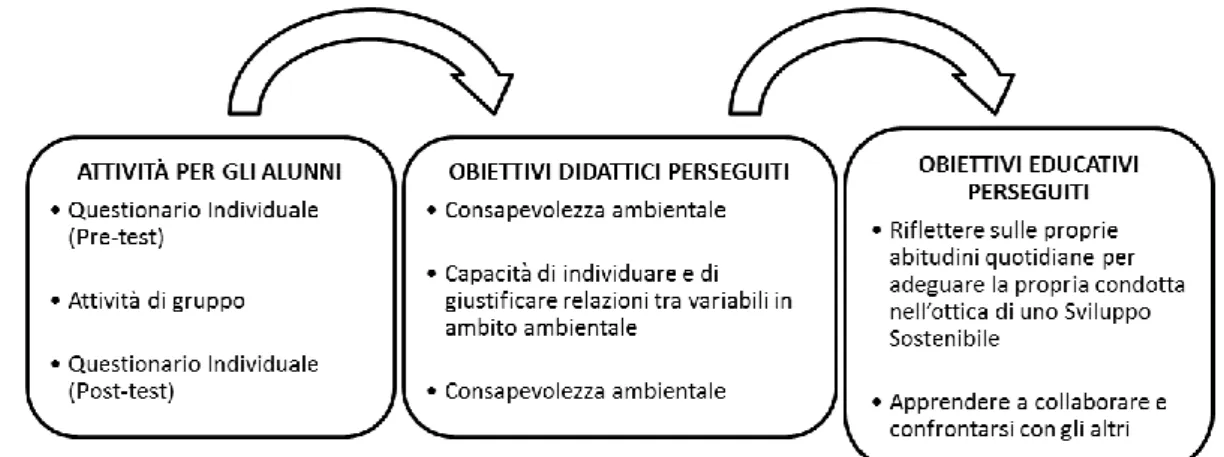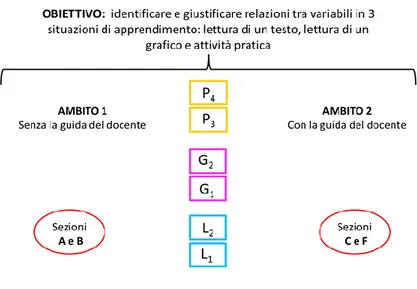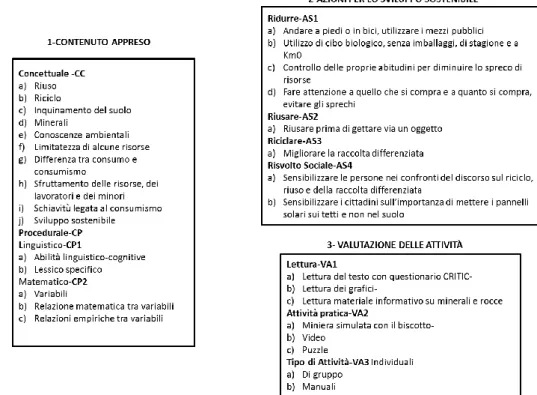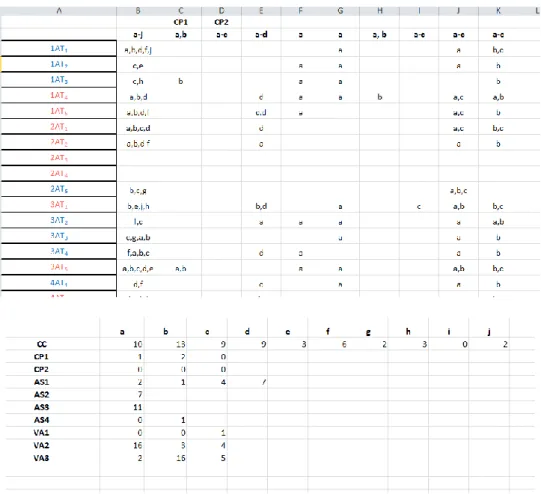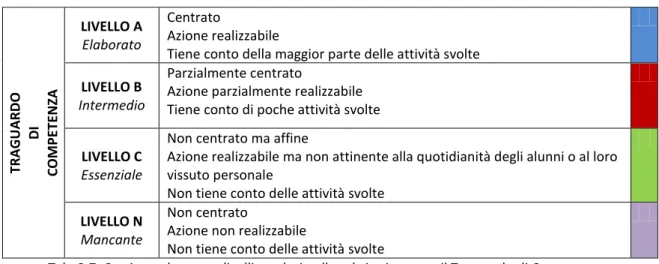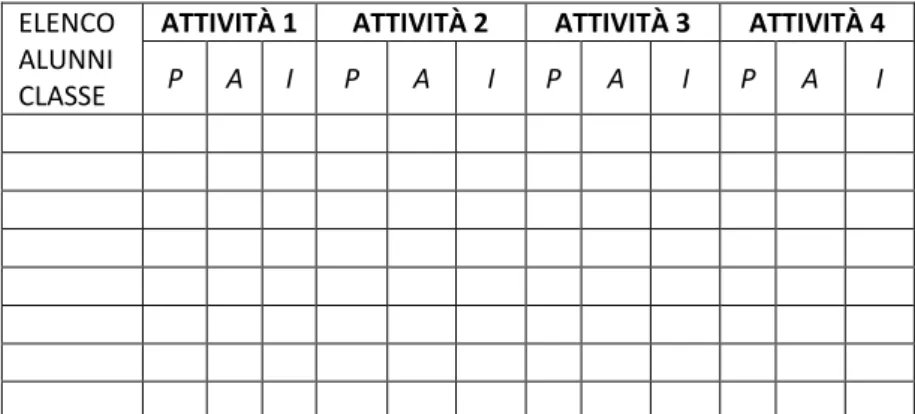U
NIVERSITÀ DEGLI STUDI DI
C
AMERINO
School of Advanced Studies
DOCTORAL COURSE IN
Science and Technology:
Chemical processes and Properties of Earth Systems
XXXI cycle
Teaching Geosciences in school using the IBSE
approach:
Mineral Resources and Sustainable
Development
PhD Student
Supervisors
“La nostra avidità e l’abituine allo spreco
perpetuano la povertà, che è un crimine contro
l’umanità.
Il mondo ha abbastanza per i bisogni di tutti,
ma non per l’ingordigia di pochi.”
Mahatma Gandhi
“Un uomo è ricco in proporzione al numero di
cose di cui può permettersi di fare senza”
INDICE
ABSTRACT ... III
LISTA delle TABELLE ... IX
LISTA delle FIGURE ... XI
LISTA delle APPENDICI ... XV
CAPITOLO 1-‐ INTRODUZIONE ... 1
1.1.EDUCAZIONE ED ISTRUZIONE ... 1
1.2. STATO ATTUALE DELL’INSEGNAMENTO DELLE SCIENZE
E DELL’EDUCAZIONE AMBIENTALE NELLA SCUOLA SECONDARIA
IN ITALIA: UNA VISIONE D’INSIEME ... 51
1.2.2. Dall’educazione ambientale all’educazione per lo
sviluppo sostenibile ... 7
1.2.3. L’educazione allo sviluppo sostenibile e l’Agenda 2030 ... 10
1.2.4. L’educazione allo sviluppo sostenibile attraverso le Geoscienze ... 12
1.3. BACKGROUND-‐STATO DELL’ARTE ... 13
1.4. L’ATTIVITA’ DI RICERCA ... 16
1.5. OBIETTIVI, FINALITÀ E SCOPI DELLA RICERCA ... 17
1.5.1. I Geomateriali, lo Sviluppo Sostenibile e l’Economia Circolare ... 18
1.6. CONTESTO AMBIENTALE SOCIO-‐CULTURALE
DELLE SCUOLE COINVOLTE ... 20
1.6.1. L’Istituto Comprensivo “Paladini”-‐ Treia ... 20
1.6.2.L’Istituto Comprensivo “Via U. Bassi”-‐ Civitanova ... 21
CAPITOLO 2 -‐ QUADRO TEORICO ... 23
2.1. PARADIGMI EDUCATIVI ... 23
2.1.1. Stili di apprendimento e competenze ... 26
2.1.2. Neuroscienze ed educazione ... 28
2.1.3. Ruolo del docente nell’apprendimento ... 29
2.2. APPROCCI DIDATTICI DELLA SPERIMENTAZIONE ... 30
2.2.1. Approccio IBSE ... 31
2.2.2. Lavoro in piccolo gruppo ... 35
2.2.3. Lettura critica: abilità cognitivo-‐linguistiche e
questionario C.R.I.T.I.C. ... 37
2.2.4. Laboratorio hands-‐on ... 39
2.2.5. Compito di realtà ... 41
2.3. APPROCCI DI ANALISI: METODOLOGIA
QUALITATIVA E QUANTITATIVA ... 43
2.3.1. Le rubriche per l’analisi qualitativa ... 44
2.3.2. Strumenti per l’analisi quantitativa ... 46
CAPITOLO 3 – MATERIALI E METODI ... 47
3.1. STRUTTURA SPERIMENTAZIONE ... 47
3.2. ATTIVITÀ RIVOLTE AI DOCENTI ... 50
3.2.1. Blocco UNO -‐ Corso di aggiornamento “Educazione ed
approccio IBSE” ... 50
3.2.2. Blocco TRE -‐ Corso di aggiornamento “Consumo consapevole delle
Georisorse in prospettiva dell’Agenda 2030: attività Inquiry
di Educazione Ambientale” ... 52
3.3. ATTIVITÀ RIVOLTE AGLI ALUNNI ... 53
3.3.2. Blocco DUE -‐ Attività 3 e 4 ... 60
3.3.3. Blocco DUE -‐ Compito di realtà ... 65
3.3.4. Blocco TRE -‐ Consumo consapevole delle Georisorse ... 68
3.4. MATERIALI PER LA RACCOLTA DATI E PER LA VALUTAZIONE
DELLE ATTIVITÀ ... 71
3.4.1. Tabella per la registrazione dell’interesse, partecipazione
ed interventi appropriati degli alunni ... 74
3.4.2. Codificazione alunni ... 74
CAPITOLO 4 – RISULTATI ... 77
4.1. PREMESSA ... 77
4.2. RISULTATI DELLE ATTIVITÀ DOCENTI ... 83
4.2.1. Abitudini didattiche dei docenti ... 83
4.2.2. Frequenza della trattazione degli argomenti di Geoscienze ... 85
4.2.3. Diffusione e gradimento dell’attività Inquiry ... 86
4.3. RISULTATI OTTENUTI DALL’ANALISI QUALITATIVA
DELLE ATTIVITÀ DEGLI ALUNNI ... 88
4.3.1. Confronto ed analisi dei risultati per ambiti ... 89
4.3.2. Analisi dei risultati delle quattro attività per ogni classe ... 91
4.3.3. Risultati relativi all’evoluzione del concetto di Sviluppo ... 95
Sostenibile e al Traguardo di Competenza (Blocchi DUE e TRE)
4.3.4. Relazioni degli alunni del compito di realtà ... 98
4.4. RISULTATI OTTENUTI DALL’ANALISI QUANTITATIVA
DELLE ATTIVITÀ DEGLI ALUNNI ... 100
4.4.1. Risultati dell’interesse, partecipazione
ed interventi appropriati ... 100
4.4.2. Risultati del questionario di riflessione sull’attività ... 101
4.4.3. Risultati divisi per genere del Traguardo di Competenza
e del concetto di Sviluppo Sostenibile ... 103
CAPITOLO 5 – DISCUSSIONE ... 107
5.1. DISCUSSIONE RISULTATI ALUNNI ... 111
5.2. DISCUSSIONE DEI RISULTATI QUANTITATIVI DEGLI
ALUNNI E DEI DOCENTI ... 121
5.3. PUNTI DI FORZA E DI DEBOLEZZA DELLA SPERIMENTAZIONE ... 124
CAPITOLO 6 – CONCLUSIONI ... 127
BIBLIOGRAFIA ... 133
SITOGRAFIA ... 142
APPENDICI ... 143
ABSTRACT
This project has the aim to promote the diffusion of Earth sciences in the Science teaching at Lower Secondary Schools in Italy (students between 11 and 14 years old). In particular, it focuses on stimulating the students’ interest on Minerals and Georesources, proposing interdisciplinary activities through the IBSE approach.
The choice of this subject resulted from the observation that Geosciences are still poorly addressed in Italian schools. In particular, topics like geomaterials (especially minerals and rocks) are usually taught in a mnemonic way without connections with the other disciplines and often disregarded as not very important even among the Geosciences teaching.
Geosciences allow in general many connections with other scientific subjects and geomaterials, in particular, can contribute to raising awareness of 14 years-‐old pupils towards the environment, natural resources and their sustainable exploitation and use. In this regard, Italian National Indications strongly recommend that students’ curricula are more focused on environment-‐friendly contents and activities as the 2030 Agenda for Sustainable Development (United Nations, 2015) suggests. Students’ natural curiosity and the possibility of merging Earth and Life sciences topics for the teaching of Environmental Education gives also the opportunity to expand the chance to address Geoscience topics with attention to interdisciplinarity.
The research project has been planned with the idea to make available to the teachers ready-‐to-‐use materials about geomaterials/georesources activities. Activities and labs were built proposing a multidisciplinar viewpoint, connecting Mathematics, Chemistry, Physics, Earth Sciences, Biology, Botany, Geography, History and Technology. In fact studying geomaterials/georesources can suggest interesting interdisciplinary connections, with ample possibility to approach modern topical subjects, suggested by the students’ everyday life or the area where they live in.
By using Earth sciences topics, and in particular the study of Georesources, the project addressed also a more general aim of investigating whether and how the students are able to identify relationships among environmental variables and justify them with different levels of correctness, completeness and pertinence. This objective was chosen because of the 2015 poor results evidenced by OCSE-‐PISA and TIMMS surveys, which revealed how mathematics and science performances of the Italian students fall below the European average. This research, therefore, aimed at verifying if a geoscience-‐related activity could improve not only the interest in Geoscience topics but also indirectly contribute to improve the scientific-‐mathematic competences of the pupils. This possibility will be also of interest for the teachers, who can appreciate the possibility of using Earth sciences topics to vehiculate STEM (Science, Technology, Engineering and Mathematics educational approach) competences by means of a transversal tool, useful to improve pupils’ scientific background.
The research addressed the study of Geomaterials using several approaches. The IBSE is the principal approach because it stimulates the formulation of questions and the development of actions to solve problems and understand phenomena. In Italy, and particular in Lower Secondary School in Marche region, the IBSE approach is still scarcely adopted as a teaching method, despite of its effectiveness and its widespread use all over the world. The IBSE approach was selected due to its structure: the
5Es phases (Engage, Explore, Explain, Elaborate, Evaluate) and the use of investigable questions. They both enable pupils to:
-‐ formulate inquiry questions with implications on real life; -‐ participate laboriously in the classroom activities;
-‐ work in groups;
-‐ promote self-‐esteem in the students who are less prone to study and participate in the classroom activities;
-‐ face complex and often interdisciplinary subjects without having a specialistic knowledge of the contents.
Inquiry and IBSE approaches are still scarcely used in the Lower Secondary School although these approaches promote and stimulate students’ involvement to scientific activities. All the activities were carried out, with individual and team work in two schools situated in Treia and Civitanova. Pupils’ answers evaluation was made using rubrics, realized during a 6-‐months period abroad under the Erasmus+ traineeship program at UAB, Universitat Autònoma de Barcelona, in Spain.
In this experimentation, the choice of using geomaterials as topic was adopted because of the personal experience as a teacher, realizing that they are a resource usually given for granted. Geomaterials are actually limited, not renewable although they are essential components in our everyday life. The contents of the activities I built up were in particular: soil consumption, waste recycling, mining extraction, recycling and reusing what previously extracted. These contents were proposed with the double purpose to spread Earth Sciences themes in the Lower Secondary School didactics and to employ them as interdisciplinary vectors, to stimulate students' sensitivity concerning themes in Environmental education. To understand how to improve pupils’ ability to establish and to justify relationships that link mankind to environment is fundamental to make young generations become aware of the environmental issues and assume responsible citizenship behaviors. Social implications involved in the issue of the Sustainable Development were processed too, including topics regarding waste management and circular economy.
The experimentation was divided in three Blocks (B1, B2, B3). Block 1 and Block 3 were addressed to teachers:
- B1 -‐ Education and IBSE approach (Par. 3.2.1)
- B3 -‐ The 2030 Agenda for sustainable development and consumption of the georesources: an interdisciplinary IBSE activity (Par. 3.2.2).
Block 2 and Block 3 were addressed to students:
- B2 -‐ Environmental education through Geosciences and IBSE approach (Chapter 3.3)
- B3 -‐ The 2030 Agenda for sustainable development and consumption of the georesources: an interdisciplinary IBSE activity (Par. 3.3.4).
Blocks B1 and B2 concerned teachers and pupils in the same school (Treia) and they went on longer than B3 activities, which concerned teachers and pupils working in the school of Civitanova. With regard to teachers’ experimentation (B1 e B3), a seminar about the IBSE approach and a practical
activity were carried out. They had the aim to collect data and to spread the IBSE approach among the teachers.
Pupils’ experimentation in Block TWO (B2) is divided in 2 individual activities (one at the beginning and one at the end) in order to evaluate not only the evolution about Sustainable Development concept but also to assess the Achievement of Expertise. There were 4 group activities through which pupils’ skills in finding and justifying linked relationships were detected according to the criteria of completeness, pertinence and correctness. Block TWO, was further divided in two Areas, 1 and 2: both provide same schedule and same activities. The only difference between Area 1 and Area 2 was the level of the researcher’s intervention as a guide during the didactic sequence. The Researcher’s guidance was basically carried out using C.R.I.T.I.C. questionnaire. In Block TWO the experimentation has been carried out for four meetings and its structure allowed to evidence:
1) pupils’ skills in finding and justifying the relationships among environmental variables;
2) the acquisition process about the concept of Sustainable Development; 3) the final Achievement of Expertise.
The part of Block THREE addressed to pupils focused on one lesson that lasted for two hours and only the acquisition of the concept of the Sustainable Development concept was detected, since the lack of time did not allow to determine the final Achievement of Expertise. Despite the different schedule in Blocks TWO and THREE, identical questionnaires and rubrics were used as tool in to evaluate and assess pupils’ answers.
Activities for teachers Block ONE -‐ B1
This activity was spilt in two interventions. At first meeting beginning teachers of kindergarden, Primary and Lower Secondary School attended to a seminar, held by researcher, about neurosciences, education and IBSE approach. Then they worked in group focusing in the formulation of an Inquiry question and in a connected activity about water, to be proposed to their students. During the second meeting the attention was shifted towards using rubrics to evaluate their own work and pupils’ too. At the end a questionnaire about the spread of IBSE approach and a satisfaction survey were proposed to teachers.
Block THREE -‐ B3
Teachers followed a seminar about Sustainable Development and on how this topic might be an inexhaustible source of hints and inspiration to address scientific topics and to contextualize them in students’ everyday life. Further interdisciplinary didactic units were carried out in collaboration with History, Geography and Italian teachers. The Inquiry activity was carried out: a revisited Wasteberg (Young, 1994) was shown and teachers were supposed to answer the IBSE question: how much waste do I produce when I throw away 1 Kg of waste? The question seems tricky but it actually encourages to think about resources consumption in the whole productive process. Waste coming from packaging (made by glass, plastic, aluminum) was used in order to focus teachers’ attention on resources and energy consume hidden behind the production of a kg of waste. At the end teachers warded a list of the geomaterials that can be recycled with huge economic and environmental
savings. A questionnaire about the spread of IBSE approach and a satisfaction survey were proposed to teachers.
Activities for pupils Block TWO -‐ B2
Block TWO is composed of four activities, each one lasting two hours. Activities 1 and 2 are similar and are both made by two parts: the first one includes a group reading of an article about soil consumption and another one about separate waste collection. After the end of the reading, according to the procedures of Area1 and Area2, there was a peer-‐reviewed answer to the researcher’s questions. The second part of each activity consists in reading a graph, related to the topics addressed by the articles, in order to allow pupils to extrapolate data and to formulate shared answers to researcher’s questions. Activities 3 and 4 were addressed through the IBSE approach since they were structured following the 5Es Learning Cycle. In the Engage phase pupils in group completed a puzzle that showed common minerals from which metallic and non-‐metallic elements are extracted; further these elements were linked with everyday objects of which each element is a component. Puzzle aimed to capture students’ attention and to introduce them to the idea that everything we use on a daily basis comes from the Earth resources. Then the IBSE question was proposed: investigate economic advantages and environmental consequences of mining. During the Explore and Explain phases, each student was given a sheet with a short description of the mining exploitation, the features of rocks and minerals, mineral distribution around the world and connections between man and minerals. This was followed by a brainstorming to share what every pupil had read, to stress the importance of mineral resources as non-‐renewable resource and to remove misconceptions. The materials to execute the mining experiment (staples, toothpicks, chocolate cookies, etc.) were delivered to pupils in order to carry out the experiment. In the Elaborate and Evaluate phases pupils resumed data collected from previous phases to verify and explain what happens if they reuse or recycle the materials they have available rather than to extract new raw materials.
Block THREE -‐ B3
This experimentation took place during the Earthweek 2017 and it was addressed to 14 years-‐old pupils. Different wastes coming from packaging (glass, plastic, aluminum) were collected in order to focus pupils’ attention to the use of Georesources and the energy required for the production of a kg of waste. Then IBSE question pupils’ were supposed to answer was showed: how much waste do I produce when I throw away 1 Kg of waste? As already said in the case of teachers’ activity, this question encourages to think about resources consumption in the whole productive process. Each group calculated how much CO2, chosen among several indicators, has been emitted for the
production of that amount of packaging and how much instead has been saved recycling it. This calculation was made with operational sheet making use of mathematical knowledge.
Then each group shared results and conclusions with other groups. At the end they rank which kind of packaging is more environmentally friendly and the concept of the 4Rs (Reduce-‐Repair-‐Reuse-‐ Recycle) was introduced. At this point interesting insights can arise to deepen interdisciplinary
connections like the different resources distribution around the world, the job exploitation, the immigration, the role of advertisement in consuming Georesources and so on.
The data collected in the experimentation were examined through a quantitative and qualitative analysis. The qualitative data have been elaborated with the aid of specific rubrics prepared by the researcher during the Erasmus Plus period carried out at the Department of Didàctica de la Matemàtica i les Ciències Experimentals at the Universitat Autonoma de Barcelona. Moreover, in the same department, on the occasion of the doctorate training days (Jornades Formatives de Doctorat), a draft of the experimentation was presented, which allowed to have interesting comments on the first results obtained and evidence some interesting aspects for future research developments. The quantitative data have been elaborated on the basis of the results emerged from the qualitative analysis and through forms completed both by the students and by the researcher herself during the activities.
The evaluation of the results from this research showed that IBSE approach combined with team working was effective from the point of view of the levels of achieved learning; in fact, pupils were able to establish and justify relationships among environmental variables, when the proposed topic is approached with these strategies. Moreover, as claimed in the implicit hypothesis, the individual improvement in the definition of Sustainable Development can be attributed not only to the repetition of the task but also to the exchange of experiences, resolution procedures and peer-‐ tutoring during team-‐working. Furthermore, the use of Georesources topics allow to address complex concepts and to reach the Achievement of Expertise.
The percentage of missing level answers before the activities testifies the very little diffusion of the concept of Sustainable Development in schools and families. After the didactic activities, the answers referring to the missing level of performance were halved and there was an overall shift towards the upper levels. In all the involved classes the number of the pupils that shifts from a lower level of performance to an upper one increased. IBSE activities and Geo-‐topics supported the achievement of these goals and they even allowed to tease out latent skills in pupils who were less prone to study. Teachers, both those who have joined the research project with their classes and those who attended the seminars, appreciated the proposed activities, not only because they were approached differently from the usual traditional teaching, but also because they were able to learn and/or refine their knowledge about the IBSE approach via practical examples. Finally, what mostly impressed the teachers, in addition to the new approach, was that the immediate reproducible and ready-‐to-‐use activities, proposed during the seminars, have been made available for using in their classes
Chapters’ contents
The first chapter presents the situation of the Italian school, how it has changed in the last decades and the condition of the Science teaching in the Lower Secondary School. New perspectives and paradigm in education are treated too. The low interest of the students towards the study of Sciences has also been highlighted, as shown by PISA and TIMMS reports in 2015. The objectives and aims of the research project are indicated, and the structure of the research activity is reported. The choice of the topic is explained.
In the second chapter the importance of the chosen topic for multidisciplinary teaching is highlighted and the usefulness of the type of didactic approach used is described. Particular attention is paid to the variety of students' learning styles and therefore the necessity of using different didactic interventions. The related methodologies are examined. Last but not least, the qualitative and quantitative methods used to elaborate and analyze the experimental data are examined and compared.
In the third chapter the three didactic blocks carried out during the PhD research are extensively described from the methodological point of view, including the materials used and the evaluation strategies and instruments: the blocks are addressed both to students (Blocks TWO and THREE) and to teachers (Blocks ONE and THREE). In particular:
Block ONE -‐ Education and IBSE approach;
Block TWO -‐ Environmental education through Geosciences and IBSE approach;
Block THREE -‐ The 2030 Agenda for Sustainable Development and consumption of the georesources: an interdisciplinary IBSE activity.
Blocks TWO and THREE are reported and explained more extensively and in details because they specifically concern the experimentation and the verification of the achievements of the aims of the research project. Moreover, the methods used to collect and process the data are explained. Specifically, the evaluation of the qualitative analysis is shown, the identification codes for data collection are clarified, the parameters considered for each level of performance and how they are represented are explained.
The fourth chapter presents the results of data processed both through qualitative and quantitative analysis, reported into specific tables and diagrams. Lastly, data referring to the students’ gender difference, and to the results from the questionnaire for teachers on the use of IBSE, compiled during the activities of blocks ONE and THREE, are also considered and processed.
In the fifth chapter the discussion about the results of the observations collected during the experimentation phases is developed. These data regard both the experimentation on students and on teachers. The results are discussed in view of the existing literature and the few teaching materials available on-‐line on comparable topics.
The sixth chapter presents the conclusions derived from the data collected during this research, as well as observations arisen from all the teaching and dissemination activities carried out during the three years of the PhD. Possible implications for the teaching of Geoscience in Lower Secondary School and for future improvements and positive interaction with teachers are reported.
The appendix contains all the materials and the teaching tools used for the experimentation. They report also ready-‐to-‐use materials created for Italian school teachers and made freely available.
LISTA TABELLE
Tab. 2.1. Confronto tra paradigma tradizionale e paradigma nuovo
(riadattato da Marina, 2017) Skinner, 1953; Piaget, 1961; Dewey, 1910;
Vygotsky, 1966; Bruner, 1967 ... 23
Tab. 2.2. Passaggio da un’educazione trasmissiva ad una trasformativa (riadattato da Sterlig, 2014) ... 24
Tab. 2.3. Stili di apprendimento e relative caratteristiche secondo Kolb (1974) ... 26
Tab. 2.4. Fasi del processo scientifico e quelle del processo creativo (riadattato da Davies, 2016) ... 34
Tab. 2.5. Corrispondenza fasi del processo scientifico,esplorazione creativa, azione e processo creativo ... 34
Tab. 2.6. Caratteristiche dell’apprendimento tra pari all’interno di un gruppo di lavoro (Duran, 2014) ... 35
Tab. 2.7. Confronto tra metodologia quantitativa e metodologia qualitativa ... 44
Tab. 3.1. Struttura dell’intera sperimentazione didattica ... 49
Tab. 3.2. Sequenza didattica dell’Ambito 1 – blocco DUE ... 55
Tab. 3.3. Sequenza didattica dell’Ambito 2 – blocco DUE ... 56
Tab. 3.4. Corrispondenza tra schede degli alunni, schede del docente ed attività in cui vengono utilizzate ... 57
Tab. 3.5. Questionario C.R.I.T.C. (Bartz, 2002) ... 58
Tab. 3.6. Corrispondenza tra livelli e colori nella rubrica inerente la definizione di Sviluppo Sostenibile ... 73
Tab. 3.7. Corrispondenza tra livelli e colori nella rubrica inerente il Traguardo di Competenza ... 73
Tab. 3.8. Corrispondenza tra livelli di padronanza, indicatori sintetici e colori ... 73
Tab. 3.9. Scheda di rilevazione da parte degli insegnanti riguardo la partecipazione (P), l’attenzione(A) e gli interventi pertinenti effettuati dagli alunni (I) ... 74
Tab. 4.1. Quadro sinottico della sperimentazione rivolta ai docenti ... 77
Tab. 4.2. Quadro sinottico della sperimentazione rivolta agli alunni ... 78
Tab. 4.3. Quadro sinottico del tipo di analisi effettuata per ciascun blocco ... 78
Tab. 4.4. Rubrica di valutazione dei livelli di prestazione degli alunni con relative ancore ... 79
Tab. 4.5. Quadro sinottico delle attività svolte con argomento ed obiettivo rilevato ... 88
Tab. 5.1. Quadro sinottico delle attività nell’Ambito 1 -‐ blocco DUE ... 108
Tab. 5.2. Quadro sinottico delle attività nell’Ambito 2 -‐ blocco DUE ... 109
Tab. 5.3. Punti di debolezza e punti di forza delle attività del Blocco DUE ... 125
LISTA FIGURE
Fig. 1.1. Il sistema educativo ed i suoi tre sottosistemi principali (Melgarejo, 2013) ... 2
Fig. 1.2. Risultati italiani secondo gli indici PISA e TIMMS (Fonte https://www.varkeyfoundation.org/teacherindex) ... 3
Fig. 1.3. Risultati finlandesi secondo gli indici PISA e TIMMS (Fonte https://www.varkeyfoundation.org/teacherindex) ... 3
Fig. 1.4. Teacher Status Index relativo all’Italia (Fonte https://www.varkeyfoundation.org/teacherindex) ... 4
Fig. 1.5. Teacher Status Index relativo alla Finlandia (Fonte https://www.varkeyfoundation.org/teacherindex) ... 4
Fig. 1.6. Cambio della prospettiva dei rapporti Uomo-‐Natura. (Fonte http://www.chalquist.com/writings/egoeco/) ... 8
Fig. 1.7. Prodotto Interno Lordo. (Fonte https://www.borsainside.com/finanzainside/pil/) ... 9
Fig. 1.8. Passaggio da un orientamento educativo competitivo ad uno collaborativo ... 11
Fig.1.9. Risultati dell'Italia a confronto negli anni 2006-‐2015 (Fonte http://www.compareyourcountry.org/pisa/country/ITA?lg=en) ... 14
Fig. 1.10. Abitudini quotidiane per uno sviluppo sostenibile. (Fonte: WWF) ... 18
Fig. 2.1. Barometro di influenza dei diversi approcci (Hattie, 2009) ... 30
Fig. 2.2. Efficacia del lavoro in piccolo gruppo (Hattie, 2009) ... 31
Fig. 2.3. Efficacia della relazione docente-‐discente (Hattie, 2009) ... 31
Fig. 2.4. Livelli Inquiry (Bell, 2005) ... 32
Fig. 2.5. Livelli Inquiry, autonomia degli studenti e guida dell’insegnante (Bell, 2005) ... 33
Fig. 2.6. Learning cycle ... 33
Fig. 2.7. Questionario C.R.I.T.I.C. (Bartz, 2002. Grafica: María Brea) ... 37
Fig. 2.8. Cono dell’apprendimento (Dale, 1969) ... 41
Fig. 3.1. Quadro sinottico della sperimentazione didattica ... 47
Fig. 3.2. Struttura dell’attività per i docenti, relativi strumenti per la rilevazione dati ed obiettivi perseguiti ... 50
Fig. 3.3. Alcune diapositive del seminario afferente al blocco UNO ... 51
Fig. 3.4. Valutazione e lavoro di gruppo durante il seminario del blocco UNO ... 51
Fig. 3.5. Wasteberg (Young and Sachs, 1994) ... 52
Fig. 3.6. Alcune diapositive del seminario afferente al blocco TRE ... 52
Fig. 3.7. lavoro di gruppo durante il seminario del blocco TRE ... 53
Fig. 3.8. Struttura delle attività con gli alunni del blocco DUE, con relativi obiettivi didattici ed educativi ... 53
Fig. 3.9. Obiettivo generale della sperimentazione e relativa differenziazione di Ambiti ed attività proposte ... 54
Fig. 3.10. Scheda D1 compilata dalla ricercatrice durante l’attività in classe ... 57
Fig. 3.11. Scheda S2 compilata dagli alunni durante l’attività in classe ... 57
Fig. 3.12. Gli alunni lavorano in gruppo per formulare una risposta condivisa ... 59
Fig. 3.13. Gli alunni realizzano il puzzle somministrato durante la fase Engage ... 60
Fig. 3.15. Materiale fornito per realizzare l’attività pratica ... 61
Fig. 3.16. Momenti di scavo della “miniera” ... 62
Fig. 3.17. Diverse modalità di calcolo della superficie della “miniera” ... 62
Fig. 3.18. Gli alunni pesano la “miniera” all’inizio dell’attività pratica ... 63
Fig. 3.19. Parte della scheda esperimento afferente all’attività 3 ... 63
Fig. 3.20. Parte della scheda esperimento afferente all’attività 4 ... 64
Fig. 3.21. Team working durante l’attività di riuso dei tappi a corona ... 65
Fig. 3.22. Orecchini e fiori realizzati con cialde di caffè e bracciali realizzati con tappi a corona ... 65
Fig. 3.23. Sequenza del riuso delle lattine ... 66
Fig. 3.24. Albero natalizio decorato con materiale di riuso ... 66
Fig. 3.25. Portachiavi realizzati utilizzando scampoli di tessuto o porzioni di vecchi indumenti .... 66
Fig. 3.26. Grembiuli da cucina realizzati recuperando un paio di vecchi jeans ... 66
Fig. 3.27. Guida, fornita dalla docente di Tecnologia, per stilare la relazione dell’attività svolta in classe ... 67
Fig. 3.28. Indicatori degli elementi presi in considerazione nella matrice per analizzare le relazioni . 67 Fig. 3.29. Matrice su file Excel per l’analisi delle relazioni del Compito di Realtà ... 68
Fig. 3.30. I Geomateriali al centro di un’attività didattica a tema ambientale ... 68
Fig. 3.31. Gli alunni separano i diversi tipi di rifiuti ... 69
Fig. 3.32. Gli alunni pesano i diversi tipi di imballaggio ... 69
Fig. 3.33. Wasteberg realizzato dalla ricercatrice in collaborazione con i colleghi del gruppo Unicamearth ... 69
Fig. 3.34. Scheda operativa alunni blocco TRE ... 70
Fig. 3.35. Schema dei dati analizzati quantitativamente ... 71
Fig. 3.36. Struttura analisi qualitativa del blocco DUE ... 72
Fig. 3.37. Struttura analisi qualitativa del blocco TRE ... 72
Fig. 3.38. Scheda compilata della partecipazione, dell’attenzione e degli interventi effettuati dagli alunni ... 74
Fig. 3.39. Codificazione alunni della classe III E di Passo Treia ... 75
Fig. 4.1. a-‐d. Abitudini didattiche dei docenti (percentuali risposte) ... 84
Fig. 4.2. Frequenza degli argomenti di Geoscienze trattati dai docenti del campione ... 85
Fig. 4.3. Conoscenza IBSE (IC “E. Paladini”-‐ Treia e IC “U. Bassi” – Civitanova) ... 86
Fig. 4.4. Punti di forza dell’attività IBSE -‐ IC “E. Paladini”-‐ Treia e IC “U. Bassi”-‐ Civitanova (percentuali risposte) ... 86
Fig. 4.5. Punti di debolezza dell’attività IBSE -‐ IC “E. Paladini”-‐ Treia e IC “U. Bassi”-‐Civitanova (percentuali risposte) ... 87
Fig. 4.6. Confronto tra Ambiti nel livello di padronanza dell’attività di Lettura del Testo-‐L1 ... 89
Fig. 4.7. Confronto tra Ambiti nel livello di padronanza dell’attività di Lettura del Grafico-‐G1 ... 89
Fig. 4.8. Confronto tra Ambiti nel livello di padronanza dell’attività di Lettura del Testo-‐L2 ... 90
Fig. 4.9. Confronto tra Ambiti nel livello di padronanza dell’attività di Lettura del Grafico-‐G2 ... 90
Fig. 4.10. Confronto tra Ambiti nel livello di padronanza dell’attività Pratica-‐P3 ... 91
Fig. 4.11. Confronto tra Ambiti nel livello di padronanza dell’attività Pratica-‐P4 ... 91
Fig. 4.12. Livelli raggiunti dalla classe AT in tutte e quattro le attività (Ambito 1-‐in autonomia) ... 92
Fig. 4.13. Livelli raggiunti dalla classe BT in tutte e quattro le attività (Ambito 1-‐in autonomia) ... 93
Fig. 4.14. Livelli raggiunti dalla classe CT in tutte e quattro le attività
(Ambito 2-‐con guida del docente) ... 93
Fig. 4.15. Livelli raggiunti dalla classe EP in tutte e quattro le attività (Ambito 2-‐con guida del docente) ... 94
Fig. 4.16. Livelli raggiunti dalla classe AT per la definizione dello Sviluppo Sostenibile ... 95
Fig. 4.17. Livelli raggiunti dalla classe BT per la definizione dello Sviluppo Sostenibile ... 95
Fig. 4.18. Livelli raggiunti dalla classe CT per la definizione dello Sviluppo Sostenibile ... 96
Fig. 4.19. Livelli raggiunti dalla classe EP per la definizione dello Sviluppo Sostenibile ... 97
Fig. 4.20. Livelli raggiunti dalla classe EC per la definizione dello Sviluppo Sostenibile ... 98
Fig. 4.21. Traguardo di Competenza raggiunto dalle quattro classi coinvolte nel blocco DUE ... 99
Fig. 4.22.a-‐b. Porzione di matrice Excel ed indicatori utilizzati per l’analisi delle relazioni ... 99
Fig. 4.23. Traguardo di competenza: gli indicatori si riferiscono alle lettere in figura 4.22.b101 Fig. 4.24. Percentuale di alunni in cui si è rilevato un aumento nella partecipazione, attenzione e pertinenza degli interventi effettuati durante le attività-‐ blocco DUE ... 101
Fig. 4.25. Grafico relativo all’affermazione “Sono stato soddisfatto del lavoro svolto” (percentuale risposte) ... 102
Fig. 4.26. Grafico relativo all’affermazione “Durante gli esperimenti mi sono divertito” (percentuale risposte) ... 102
Fig. 4.27. Grafico relativo all’affermazione “Ho imparato nuovi concetti” (percentuale risposte) 102 Fig. 4.28. Grafico relativo all’affermazione “Le schede operative fornite erano utili” (percentuale risposte) ... 103
Fig. 4.29. Percentuali di maschi e femmine nel Blocco DUE della sperimentazione ... 103
Fig. 4.30. Livelli di padronanza del Traguardo di Competenza-‐Blocco DUE per genere ... 104
Fig. 4.31. Percentuali di maschi e femmine nel Blocco DUE e TRE della sperimentazione ... 104
Fig. 4.32.a-‐b. Livelli di padronanza per la definizione di Sviluppo Sostenibile prima dell’attività per genere ... 105
Fig. 5.1. Risultati consuntivi dell’Ambito 1 per livello di prestazione -‐ Classi AT e BT ... 112
Fig. 5.2. Risultati consuntivi dell’Ambito 2 per livello di prestazione -‐ Classi CT e EP ... 112
Fig. 5.3. Livelli di prestazione -‐ Attività di lettura di un testo separata per Ambito ... 114
Fig. 5.4. Livelli di prestazione -‐ Attività di lettura di un grafico separata per Ambito ... 115
Fig. 5.5. Livelli di prestazione -‐ Attività pratiche separate per Ambito ... 116
Fig. 5.6. Confronto tra tutte le attività del Blocco DUE per livelli di prestazione ... 117
Fig. 5.7. Evoluzione dei livelli di prestazione nella definizione di Sviluppo Sostenibile-‐Blocco DUE e TRE ... 120
Fig. 5.8. Aumento degli indicatori per ogni attività-‐Blocco DUE ... 122
Fig. 6.1. Wordcloud contenente le parole più frequentemente usate nelle relazioni ... 131
LISTA APPENDICI
Appendice 1: Questionario abitudini didattiche ... 143
Appendice 2: QUESTIONARIO DOCENTI-‐Diffusione e gradimento attività Inquiry ... 146
Appendice 3: SCHEDA S1 ... 148
Appendice 4: SCHEDA D1 ... 149
Appendice 5: SCHEDA S3 ... 150
Appendice 6: SCHEDA DELLE DEFINIZIONI – S2 ... 151
Appendice 7: #stopalconsumodisuolo ... 153
Appendice 8: MARCHE, DAL RICICLO UN TESORO NASCOSTO ... 155
Appendice 9: IL MODELLAMENTO DELLA SUPERFICIE TERRESTRE ... 157
Appendice 10: CHE COSA SONO I MINERALI E LE ROCCE ... 158
Appendice 11: RISORSE MINERARIE ... 159
Appendice 12: CHE COS’E’ UNA MINIERA ... 160
Appendice 13: L’ESSERE UMANO, I MINERALI ED I METALLI ... 161
Appendice 14: SCHEDA ESPERIMENTO-‐Estrazione mineraria del Rame (Cu) ... 162
Appendice 15: SCHEDA ESPERIMENTO-‐Riuso e riciclo dei minerali-‐ Cu ... 163
Appendice 16: Questionario sulla Consapevolezza Ambientale PRIMA dell’Attività ... 164
Appendice 17: Questionario sulla Consapevolezza Ambientale DOPO l’Attività ... 165
Appendice 18: Questionario Riflessione Attività Alunni ... 166
Appendice 19: SCHEDA OPERATIVA ... 167
Appendice 20: RUBRICA DEI LIVELLI– IDENTIFICAZIONE E GIUSTIFICAZIONE DELLA RELAZIONE ... 168
Appendice 21: LIVELLI DI COMPLETEZZA, PERTINENZA E PRECISIONE APPLICATI NELLA RUBRICA DI INDIVIDUAZIONE E GIUSTIFICAZIONE DELLA RELAZIONE ... 172
Appendice 22: RUBRICHE PER ANALIZZARE I TRAGUARDI DI CONOSCENZA E COMPETENZA ... 174
Appendice 23: Scheda rilevazione atteggiamento alunni ... 175
Appendice 24: Materiali per la realizzazione dell’attività del Wasteberg in classe ... 176
Appendice 25: CIOCCOLANDIA: SCHEDA DOCENTI ... 182
CAPITOLO 1 - INTRODUZIONE
1.1 EDUCAZIONE ED ISTRUZIONE, SPESA O INVESTIMENTO: UNA DIATRIBA DI ANTICHE RADICI La parola educazione deriva dal latino e-ducere, il cui significato è associato sia ai verbi “condurre, guidare”, che ai verbi “portar fuori, far emergere” e generalmente indica un processo di strutturazione globale della personalità (apprendimento in senso lato, socializzazione, acculturazione). Ambedue le accezioni inducono una visione con sfumature leggermente diverse del processo educativo. La prima evoca l’azione di accompagnamento che l’educatore (genitori, maestri, docenti, istruttori, formatori, ecc.) deve mettere in pratica per favorire la crescita fisica, culturale, morale e spirituale degli educandi. La seconda insiste sul carattere originale della personalità dell’educando e sul ruolo maieutico di aiuto alla presa di consapevolezza e allo sviluppo di tutte le sue potenzialità (conoscitive, operative, affettive e valoriali). Il termine istruzione deriva invece dall’etimo latino in-struere cioè “costruire, fabbricare” ma anche “ammaestrare, informare” e contrassegna invece il conseguimento di nozioni e di caratteristiche comportamentali e cognitive determinate (apprendimento in senso stretto). In realtà l’espressione latina instruere (“costruire, preparare”, anche “insegnare”) deriva da struere “collocare a strati, connettere”. Dall’etimo della parola viene quindi richiamato non solo il promuovere l’acquisizione di conoscenze e abilità, ma anche il favorirne una loro organizzazione interna, interiorizzata, coerente e permanente. In questo senso Bruner (1967) propose una teoria dell’istruzione che mirava a individuare i nuclei fondamentali, le idee generatrici, i principi di sviluppo che costituiscono l’ossatura portante delle varie discipline e concentrare l’insegnamento su questi elementi essenziali, più che disperdersi in una molteplicità sconnessa di nozioni e procedure particolari. In ciò si evoca il detto di Morin (1999): “È meglio una testa ben fatta, che una testa ben piena”.
L’insegnamento è ovviamente una componente dell’educazione; accanto al verbo insegnare si accostano normalmente altri termini che tendono a integrare e approfondire lo stesso concetto di insegnamento. Essi sono: educare, istruire, formare. L’espressione più generale, che attraversa ormai l’esperienza umana lungo tutto il suo arco esistenziale, è educare. Negli anni settanta del secolo passato si diffuse una forte polemica circa il ruolo della scuola, in particolare della scuola pubblica, nel contesto sociale della comunità nazionale italiana. A essa si attribuiva un ruolo semplicemente istruttivo, nel senso di promozione della crescita culturale degli studenti, mentre le veniva negato quello più propriamente educativo, legato allo sviluppo di una identità personale e all’interiorizzazione di valori morali e spirituali (Spiazzi, 1994). Uno dei tanti slogan era: “alla scuola l’istruire, alla famiglia l’educare”. Tuttavia molte leggi europee, compresa la legge italiana, prevedono oggi come finalità propria dell’istituzione scolastica quelle dello sviluppo spirituale e morale, oltre che culturale, sociale, fisico e professionale degli studenti. La legge italiana afferma che “sono promossi il conseguimento di una formazione spirituale e morale, anche ispirata ai principi della Costituzione, e lo sviluppo della coscienza storica e di appartenenza alla comunità locale, alla comunità nazionale ed alla civiltà europea” (Legge 53 del 28 marzo 2003, art. 2, comma 1b).
È proprio con quest’ultima accezione che Melgarejo (2013) presenta il sistema educativo come l’insieme delle influenze educative che una persona riceve dalla nascita all’età adulta attraverso le istituzioni, le agenzie educative e le organizzazioni formali di una società che trasmette conoscenza e la relativa eredità culturale, che influisce nella crescita sociale ed intellettuale dell’individuo. Il
sistema educativo è dunque un sistema aperto che ha, come conditio sine qua non per la sua esistenza, la presenza di un flusso costante di relazioni costruttive con l’ambiente sociale, culturale, economico, politico etc. Il sistema educativo è un sistema complesso composto basicamente da tre sottosistemi: il sottosistema familiare, quello scolastico e quello socioculturale. Questi tre sottosistemi sono in costante contatto e si retroalimentano in modo da
costituire un congiunto, il sistema educativo, cioè un insieme che va molto piú in là delle singole parti di cui è composto. Ogni sottosistema del sistema educativo (Fig. 1.1) è rappresentato da tre ingranaggi in contatto tra loro: se uno di questi ingranaggi non funziona o si muove in direzione opposta agli altri due tutto il meccanismo si inceppa e gli alunni rimangono bloccati durante il loro processo di costruzione cognitiva ed affettiva.
Il cuore del sistema educativo sono i valori della società che si articolano in ciascun sottosistema affinchè possano implementarsi e che ogni sistema educativo reitera e trasmette alle nuove generazioni. Ad esempio, nel caso della Finlandia tali valori sono equità ed efficienza, nel caso dell’Italia sono valori di libertà e uguaglianza (Linnakylä, 1996). In Finlandia, a seguito di politiche non solo scolastiche ma anche economiche, i sottosistemi familiari e sociali si rafforzano l’un l’altro affinché il terzo ingranaggio, la scuola, garantisca che tutti gli alunni abbiano le stesse opportunità, poiché viene dato per certo che senza pari opportunità il merito si ridurrebbe a semplice competizione tra privilegiati. Il felice esito del sistema di educazione finlandese è sotto gli occhi di tutti ed è un successo omogeneo in tutto il paese, poichè generalmente la varianza interna dei risultati PISA-OCSE finlandesi è la seconda piú bassa dei paesi analizzati (OECD PISA 2015). Questo significa che la differenza tra i centri selezionati per lo studio è scarsa. I test PISA nel corso degli anni mostrano che questi risultati di eccellenza sono stabili nel tempo, al contrario dei risultati di altri paesi (per esempio Italia e Spagna), dove sono registrate fluttuazioni in positivo o in negativo molto pronunciate. La tendenza alla stabilità del miglioramento è corroborata dalle rilevazioni PISA (2003-2015) nel corso del tempo, non solo per la competenza lettoria, ma anche per le competenze dell’asse matematico scientifico. Tuttavia, se si prende in considerazione anche l’indice TIMMS per la classe 4^ della scuola primaria, si può notare che i risultati ottenuti dagli alunni italiani (Fig. 1.2) non sono poi così lontani da quelli ottenuti nei paesi scandinavi (Fig. 1.3).
Fig. 1.1. Il sistema educativo ed i suoi tre sottosistemi principali
Fig. 1.2. Risultati italiani secondo gli indici PISA e TIMMS (Fonte https://www.varkeyfoundation.org/teacherindex)
Fig. 1.3. Risultati finlandesi secondo gli indici PISA e TIMMS (Fonte https://www.varkeyfoundation.org/teacherindex)
Questo avviene nonostante l’investimento in educazione di questi ultimi sia molto più elevato (Danimarca: 7,7% del PIL, Norvegia: 6,4% del PIL, Italia: 4,5% del PIL secondo i dati relativi al decennio 2006-2016 della Banca Mondiale, reperibile https://ec.europa.eu/eurostat/web/national-accounts/data/database) ed il loro stato sociale, molto più sviluppato che in Italia, offra maggiore appoggio sociale per le pari opportunità non solo per gli studenti, ma in generale per ogni componente della società. Questo vale non solo per le rilevazioni PISA ma anche per altri indici di ricerca quali il TIMSS (Trends in International Mathematics and Science Study, IEA 2011). Considerato questo, si può dire che i risultati degli alunni italiani – almeno nel I ciclo di istruzione - sono più positivi di quanto non venga detto usualmente dai mezzi di comunicazione, e questo è dovuto al fatto che gli insegnanti, appartenenti al sottosistema scuola, suppliscono con la loro creatività ed il loro lavoro, spesso mal retribuito o retribuito solo in parte, alla mancanza di risorse economiche e al riconoscimento sociale del proprio lavoro. In aggiunta a questo, in Finlandia la scuola è orientata come un’organizzazione di apprendimento dove i docenti hanno un carico burocratico minimo1; in Italia, al contrario, molto spesso i docenti ricoprono incarichi aggiuntivi all’interno della scuola e spesso sono oberati di lavoro amministrativo che esula completamente dal loro compito educativo e che compete di più a ruoli di segreteria. In Finlandia, inoltre, esiste un corpo docente di livello culturale molto elevato, ben remunerato, con buone condizioni di lavoro ed un gran prestigio e riconoscimento sociale, mentre l’Italia a tal riguardo si posiziona tra i paesi più svantaggiati (Fig. 1.4 e 1.5).
